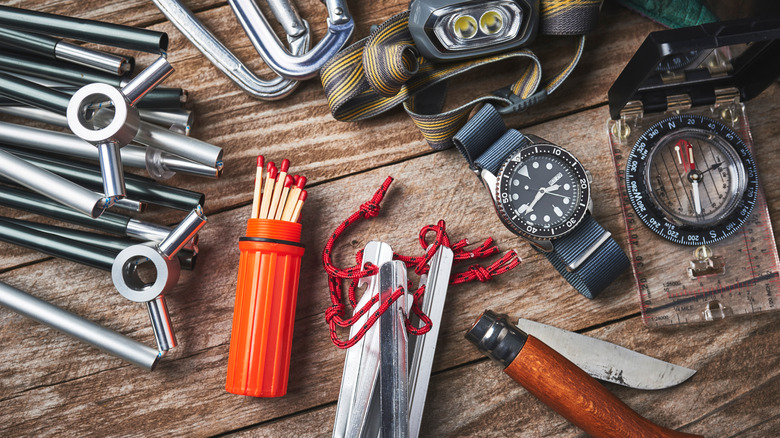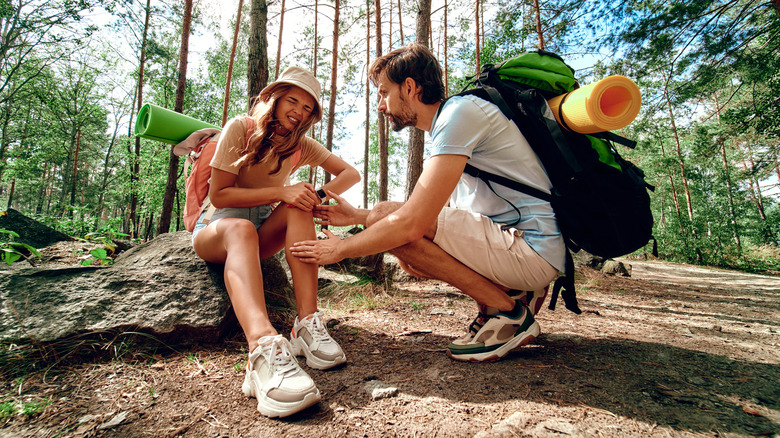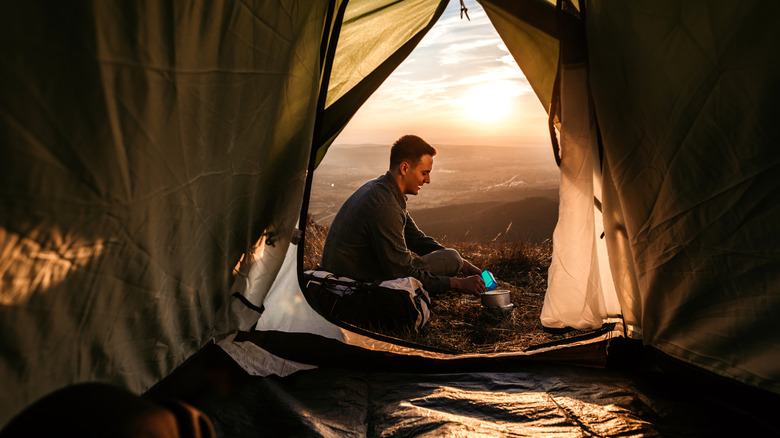A DIY Pill Bottle Survival Kit Is The Perfect Addition To Your Camping Gear
Outdoor enthusiasts will know that safety is the top priority. The unpredictability of nature, combined with the possibility of getting stranded, means preparation is key — and it emphasizes the need to have a great survival kit at hand. Filled with essential items that can have your back during an unexpected emergency, a well-made survival kit can make the difference between a smooth recovery and a catastrophe.
And believe it or not — you don't need to carry a massive bag to have a trove of survival essentials at hand. On the contrary, popular YouTuber Living Survival has come up with a crafty way to get everything you need inside your pocket. Enter: the pill bottle survival kit. Filled with items crucial for first aid, fire-starting, signaling, navigation, and even fishing, this compact lifesaver can be a game-changer in critical situations and help you feel safer while hiking.
Putting together your kit is simple. First, start by thoroughly cleaning your pill bottle. Try and choose one with a childproof tab for added security. Next, the survival expert suggests wrapping the exterior with a durable Kevlar cord that you can use in different scenarios — from securing items to using it as a fishing line. Once that's done you can start filling your bottle with an assortment of survival necessities.
Carrying all your survival essentials
According to Living Survival, your pill bottle survival kit should address five vital needs: blade, aid, shelter, ignition, and sustenance. That way, you'll establish a strong foundation that can help ensure your safety and increase your odds of survivability in unforeseen circumstances.
For your blade, a compact razor that folds out is a great tool that's suitable for a variety of basic tasks. In terms of aid, duct tape is an underrated essential — from wound dressing to helping you remove splinters — it's highly versatile and serves a multitude of purposes. Additionally, since regular medicine tubes tend to be quite bulky, he suggests using a straw, filling it with the necessary ointment, and sealing the ends with heat. Essential documentation — like emergency contacts, insurance information, and more — can be neatly folded up inside. Lastly, for ignition, stormproof matches and a striker are indispensable.
Throwing in a few extra items can also help enhance your kit's versatility. This might include things like cotton balls for tinder, a small mirror glued to the inside of the cap for signaling, a miniature whistle for alerting rescuers, water treatment tablets, and a compass for navigation in case you get lost on a hike. One last thing to include? A MacGyver tool — aka a paper clip. Using it as a finger or toe splint, converting it into a fishing hook or needle, or transforming it into a meat skewer, paper clips offer surprising adaptability in pinch situations.
Safety comes first in the outdoors
Hitting the outdoors is both thrilling and rejuvenating, but no level of enthusiasm for adventure beats prioritizing safety. According to a report by Hikers Daily, there are an estimated 4,000 to 5,000 outdoor-related injuries each year, with nearly 50% of these related to falls/slips and often resulting in minor injuries. Nonetheless, fatal accidents aren't rare. According to News Nation, data collected by the Public Risk Management Program of the National Park Service reported that more than 2,600 National Park visitors suffered fatal accidents between 2014 and April 2023.
After all, the U.S. boasts several renowned but dangerous hikes — like the Angels Landing in Zion or the Half Dome in Yosemite. Sure, these destinations offer awe-inspiring views, but they also come with their fair share of hazards — including narrow pathways, steep drops, slippery rocks, and unpredictable weather. And while avid hikers are often drawn to these challenges, even the most experienced enthusiasts can attest to the importance of being well-prepared and having the right gear.
That said, compact multi-purpose tools like a pill bottle survival kit are game-changers. But their value isn't just in their size; it also lies in their ability to serve various critical functions. That, combined with understanding the nuances of outdoor safety, recognizing potential hazards, and using previous knowledge to navigate or mitigate those risks, can make a life-saving difference. Carrying a small survival kit isn't just about being space-efficient — it's about ensuring you're equipped for whatever nature might throw your way.


